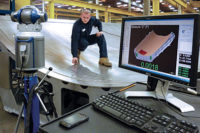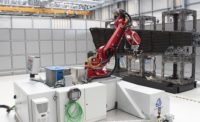Building aircraft has always been a struggle between the size of their components and the need to craft them carefully. More than any other device, airplanes epitomize the concept that “the devil is in the details” because in small errors lies the potential for great mischief such as increased drag and decreased range. The trend is for smoother transitions and, where possible, jointless design. Even the ubiquitous rivet is disappearing, at least from exterior surfaces, replaced by composites that flow uninterrupted from one section to another.
In the past, large structures such as wings, fuselages, or vertical stabilizers were difficult to make alike because there was no good way to measure them. The traditional measuring standard for objects over 20 feet was the theodolite. But theodolites were invented to measure the altitude of weather balloons, not pinpoint the end of a forged spar, 50 or 100 feet distant. Although theodolite measurements can be fairly precise, they are subject to interpretation and as such are not always reproducible. Also, theodolites are slow, and using them can take several days to measure a few hundred points, depending on obstructions.
With the advent of the laser tracker, precise, rapid, reproducible measuring over great distances finally became a reality. Capable of gathering hundreds of points in hours, not days, laser trackers shouldered aside theodolites and became the new portal to aircraft design, modeling, tool making, manufacturing, and quality checking, worldwide.
Although laser trackers are used to align large industrial equipment such as metal rolling mills, printing presses, and power generation equipment, one can imagine that they were created expressly for the aerospace industry. A laser tracker can be set up anywhere, in a design studio or factory, and its vast operating range is large enough to capture the wing of the biggest planes ever conceived.
Operation of the instrument is simple. The tracker mounts on a tripod and emits a laser that is reflected off a target positioned at the point to be measured. As the operator moves the target from point to point and the light is reflected back to the tracker, the distance to each point is calculated. The laser tracker is linked to a portable computer where real-time measurements are verified against a master CAD file. Since it is accurate and simple to operate, many users also apply it to parts that are modest in size—around three feet on their largest dimension.
The measuring rate of a laser tracker is at least 20 times faster than theodolites. As a result of its speed, engineers can take dimensional snapshots of a project as they make incremental changes to a model or tool layout, and then measure it with the laser tracker to see how parts or surfaces interact with each other. Since each measuring cycle usually takes only a couple of minutes, adjustments can be small, enabling the design team and tool makers to prudently close in on the final shape they are seeking.
MAKING TOOLS
Repeatability and replaceability of parts and assemblies has existed for some time, but the quality is constantly improving. Along with this comes the need to pre-think how subassemblies come together and are joined. Today the focus on tooling is even greater than for any previous generation of aircraft, for both metal and composite parts. For this industry, tool making, machine tool calibration and monitoring is where a laser tracker has the greatest benefit.
COMPONENTS OF AN AEROSPACE TOOL
The main structure of an aerospace tool is its frame. The frame is a heavy-duty welded structure that is typically made of the same material as the part so that both the part and the frame expand and contract at the same rate (due to any changes in temperature).
Other aspects of the tool are referred to as “details”. The first type of detail is a pad. Pads are a protected place for the part to rest against. Pads can be flat (planar) or curved, depending on the size and shape of the part. Working along with the pads, clamping fixtures force the part tightly against the pad.
The second type of detail is a hole locator. Hole locators have pins of various shapes that the allow the user to correctly position the part on the tool.
Pads are perfect for supporting the part but they will generally secure it in only one direction. The hole locators are then used to ensure the repeatable positioning of the part in the final assembly. This can be accomplished by using pins that match up against either holes or slots to constrain movement in specific directions or orientations. Together, these details provide the control systems that ensure that the design intent is achieved.
When tool engineers lay out assembly fixtures, they arrange them loosely, and then adjust the location of individual details with a laser tracker until the whole conforms to the CAD file.
TYPES OF AEROSPACE TOOLS
An assembly tool contains the part locating details that hold multiple components together so that they can be fastened to create the assembly. Various assembly tools can serve a range of functions.
Typically, the first assembly tool is used to put the major components together, while subsequent tools locate frames, stringers, and other support structures for the part. The last tool positions the skin onto the final assembly, and the skin is then fastened to the frame.
When building a tool, a laser tracker is first used to get the frame structure in place. It is then used to set the details, making sure that the pins and pads are all in the correct locations. The laser tracker also allows for measurement directly against a CAD file when setting complex-shaped details.
A fabrication tool has the same locating details as an assembly tool, but it adds details with drill bushings and other structures to allow for part fabrication. In addition to what a laser tracker measures on an assembly tool, the measurements also confirm that the drill bushings and complex shape guides for routing or trimming parts are in the correct location.
After a tool is installed, the laser tracker is used to measure all the details and reference points to make sure they are correctly placed, and to establish a master reference system for future maintenance and inspection of the tool.
TOOL SET-UP
Changing ambient temperature is another situation in which a laser tracker simplifies tool setup. Every five seconds, the instrument samples the ambient temperature, pressure, and humidity, automatically compensating for any environmental changes to ensure accurate results from the laser tracker. As the environment changes, the tool will expand or contract. Software allows the user to compensate for tool expansion/contraction based on the alloy or previously measured reference points that were obtained during the certification/qualification process. The job can then be scaled based on this data.
Fixtures for riveted parts are set up similarly. Most begin as a flat plate onto which holding brackets are arranged to fix the loose parts. When “best fit” positions are determined on a model reference tool, the laser tracker becomes the tie between the reference and the working tool. With the laser tracker, engineers make sure that brackets on the tool mimic those on the reference. Once setscrews on the brackets are locked, the tool is ready to produce a first article part.
MODELING AND ANALYSIS
Aircraft design is inseparable from tooling design, and today both disciplines follow parallel paths of development. Once a design concept is hardened, a laser tracker becomes involved in laying out physical models, ensuring that both the parts and the tooling conform to the virtual models.
Modifications, such as a new wing-root profile, are analyzed by capturing the changes with the laser tracker, then feeding these back to a surfacing program where it is reconstituted as a new virtual model. Subsequently, the modification can be checked for structural analysis or by CFD for drag and flow properties.
TOOLS FOR COMPOSITE PARTS
The laser tracker has become critical to the development of molds and winding mandrels for composite parts because some of these are huge, particularly those on military and business jets.
For instance, the molded wing skin for the F-35 is 50 feet long, and a molded stabilizer for a military transport is 45 feet high. Even some winding mandrels produce fuselage parts that exceed 10 feet.
Just as vital as the instrument’s size capability is its accuracy. This becomes important where the production parts will be interchangeable.
Mold making remains something of an art, but digital metrology is turning it more in the direction of science, minimizing trial and error. When a toolmaker receives the model of the structure, such as awing or tail part, they create a virtual tool that includes the molding surfaces. The art comes in knowing how to construct the overall tool so that the mold surface is supported rigidly and will not deflect under the weight of the mass of polymer. Today, mold makers rely on Invar, an alloy with a very low coefficient of thermal expansion. Its thermal stability makes it ideal for B-stage resins that will be cured in an autoclave. The downside of Invar is that it is expensive and difficult to machine, so it is important to avoid machining mistakes.
Molds are comprised of two regions, the solid surface that is in contact with and shapes the composite, and a support structure. Both are crafted from Invar. Absolute rigidity is essential. Once the mold surface is formed, the support structure must be machined so that the off-side of the mold surface perfectly “nests” in and is supported by the structure. Each vertical column in the support structure is like a bracket beneath the molding surface. To get the nesting shape correct, toolmakers use a laser tracker to measure cuts in the structure until the nest exactly matches the underside of the mold.
Few designs ever make it all the way to assembly untouched, but with a laser tracker, modifications do not have to slow down tool development; the laser tracker can be used to position running modifications. By locating a modification such as an extra support bracket or hole with the laser tracker, engineers only have to do it once because positioning is so precise.
Surfaces of molds and winding mandrels are checked quickly with a laser tracker. By sliding the target sphere over critical sections of the tool surface, a technician generates a line of points in the instrument’s computer, not just a single point. By covering the region on the tool in a grid pattern, the technician captures the shape of its surface, as a 3-D point cloud. Comparing this to the surface CAD file instantly tells tool developers where and how much the surface needs to be modified.
The latest trend in prototype development is using a laser tracker to build directly to a CAD model, eliminating the need for hard fixtures that would only be used once or twice before being discarded.
The laser tracker, acting like a virtual gage, is used to build temporary or modular tools like giant erector sets that may be reconfigured in minutes, saving hundreds of thousands of dollars in tooling costs for new programs.
MANUFACTURING AND CERTIFICATION
Once tooling produces one-off parts with satisfactory dimensions, the challenge is to see how it works in production. The laser tracker simplifies this process. First article parts are measured with the instrument and compared to the design standard. Any adjustments that need to be made to the tooling show up instantly on the instrument’s operating program.
RE-CERTIFICATION OF TOOLING
Finally, tools change with use. Since composites are highly abrasive, molds and mandrels wear with use. The laser tracker gives aircraft producers a simple, fast means for re-certifying tooling to design specifications. For example, a typical 50-pin tool can usually be checked in as little as 10 minutes.
SUMMARY
No other instrument enables aircraft builders the ability to “get their arms around” the entire manufacturing process—from design to final dimensional checking. Due to its enormous range, precision, speed, and communication capability, the laser tracker gives aerospace manufacturers the ability to be more cost competitive by shifting the whole process of design and development into the virtual realm.
FARO Technologies Inc.
(800) 736-0234




